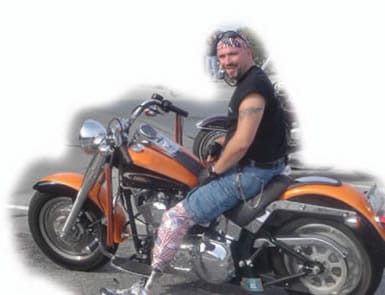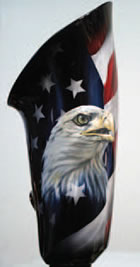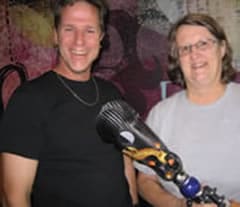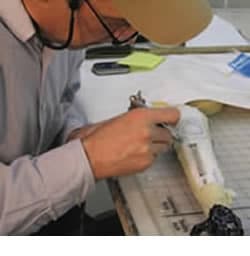Volume 19 · Issue 7 · November/December 2009 | Download PDF
by Elizabeth Bokfi

Bob King proudly wears one of SleeveArt’s patrioticpatterned socket sleeves
Photo courtesy of Kathy Montgomery
“Bad year, that 2007,” I tell people when they ask me what happened to my leg. It’s a generic statement I’ve seamlessly incorporated into my conversations now, almost 3 years since my amputation surgery. The discovery of a bone tumor in late 2006 left me a left-side, belowknee amputee in January 2007.
“It’s part of my rehabilitation!” is the other statement I use when asked about the decorative fabric sleeve that I slip over my socket when I wear shorts to the gym. And when I look at my prosthetic leg, taking in the whole picture of myself in the full-length mirror standing in front of me, I realize it’s not so bad. Better than dead. I survived heavy-duty chemotherapy; therefore, I can survive others’ stares and curious questions.
My boyfriend and I have actually turned it into a game – a bet whether or not passersby on the waterfront boardwalk will blatantly stare at my leg or pretend they don’t notice. It’s a classic “darned if you do and darned if you don’t” situation. If I cover it with a decorative sleeve, people stare. If I don’t cover it, people stare. If I wear long pants, I have a meltdown in the searing summer heat.

An example of GTOPI custom work
Photo courtesy of Mark Dalton Art Studios
As every amputee is acutely aware, there is a period at the beginning of the journey to acceptance (sometimes that “beginning” lasts a very long time) when we might feel embarrassment or shame at our physical appearance. Sometimes, the amputee attempts to conceal his or her self-perceived disfigurement. The shank of our prosthesis isn’t yet closed in. Our pant legs get caught on it if it’s windy, exposing it to public view. Trying on a pair of shoes discreetly (Where are the shoehorns?) is next to impossible when all the benches seem to be located at the ends of the aisles leading to the store’s main corridor. And for those of us who still care, prosthetic legs and bikinis just don’t match – just try to find the prosthetic sleeve’s patterned Lycra® in the same fabric as your swimsuit – it’s impossible!
Kurt “Fred” Pauloz, president of Fred’s Legs, a company in Dania Beach, Florida, which manufactures SleeveArt®, has his own story. His business grew from a need he first discovered for himself as an amputee. Becoming an amputee at age 18, Pauloz found his life literally changed overnight. For many amputees, Pauloz included, a prosthesis is viewed as a mobility device, a means of returning to a reasonably mobile state.
“I knew that whatever was coming would never replace what I had lost,” says Pauloz, who is also a certified prosthetist. “I learned early on that what I needed was something to help me get around easier and back to a somewhat normal life. I was not looking to replace, imitate or recreate the leg I had lost; I just wanted to be able to get around pain-free.”
Later, when he had his leg cosmetically finished, Pauloz felt that the traditional prosthetic sleeves had a strange color that approximated but couldn’t match one’s skin tone, and they appeared sloppy because they got so dirty with everyday use. At the same time, Pauloz also experienced more people feeling awkward to talk to him, some telling him that they felt sorry for him.
Love ’em or Sleeve ’em
Amputee Supplies, Inc.
Fred’s Legs
SleeveArt® by Fred’s Legs, Inc.
P.O. Box 655
Dania Beach, FL 33004-0655
954/646-1026
Global Tattoo
Orthotic Prosthetic
Innovations
2891 Lowren Loop
Port Orchard, WA 98366-4085
360/895-1976
SocketSkinz
2101 Spring Hollow Path
Round Rock, TX 78681
SocketSkinz.com
SleeveArt began as an idea to change the prosthetic sleeve’s appearance from something dingy to something exciting. Amazingly, after Pauloz’s wife, Joanne, began sewing his prosthetic sleeves, Pauloz discovered that the sleeves had an effect on those around him. In addition to changing his own self-perception, he found that the sleeves helped make others feel comfortable around amputees.
Not only does Pauloz supply prosthetists and amputees with slip-on covers for prosthetic sockets in patterned stretch fabric, but his socket covers are also used in a laminating process that adheres the fabric permanently to the socket. Clients have a wide variety of patterns to choose from, including patriotic flags, flowers and – for the flamboyant or adventurous – psychedelic patterns.
“Years later, there are 70 styles for all tastes, and not a single day goes by without someone stopping me in amazement at how great my leg looks,” says Pauloz. “It somehow seems to change peoples’ lives, both amputee and nonamputee.”
Bob King from West Virginia, a longtime client of Fred’s Legs, used SleeveArt as a changeable accessory when he was a below-knee amputee (BK). Although he is now an above-knee amputee and chooses not to cover his socket, back then it was fun for him to change the sleeve to a different one whenever the mood struck him.
“When I was a BK, I used the sleeve covers because I thought of the leg as more of an accessory and thought it was cool being able to change its appearance,” says King. “I also found it interesting because I knew that most people were looking at my prosthesis, but the covers made me feel like they were looking at something more than that. Seeing how I never wore clothes that covered either the below-knee or above-knee prosthesis, the covers were more decorative than anything else.”

Dan Horkey, founder of GTOPI,
shows off one of his company’s designs
Photo courtesy of Dan Horkey
Then there’s Dan Horkey, a motorcycle accident survivor, who experienced a brief period following his amputation in 1985 when venturing out in public using crutches without his prosthesis embarrassed him. Although that initial period didn’t last long, Horkey’s 20 years of covering his prosthesis with shaped foam eventually did lead to dissatisfaction with its appearance, motivating him to start a business that would serve the cosmetic needs of amputees. Searching for art at fabric stores, the Port Orchard, Washington, resident discovered his choices were limited.
“I’d always chosen to have my prosthesis covered with a shaped foam cover with a spray-on skin tone that didn’t really match my sound leg in color or shape,” he says. “After a couple of adjustments cutting into the posterior skin, it really didn’t look so good, and I was unhappy with the appearance.” When carbon braided substrates hit the market in the ’90s, he chose not to cover the socket and device.
“The prosthesis was never something that I felt I should hide,” he says. “If anything, I felt I was promoting awareness and public acceptance by wearing shorts in public. I’d seen a few amputees with laminated fabric art over the last 20 years. I didn’t know where to purchase it. It wasn’t readily available and was a cosmetic choice rarely offered to me.”

Artist Mark Dalton’s experience of painting
Harley-Davidsons and hot rods is applied
to one of GTOPI’s custom orders.
Photo courtesy of Dan Horkey
In 2004, Horkey was offered a technician’s position at Hanger Orthopedic Group in Tacoma, Washington, which opened the door to starting his own business, Global Tattoo Orthotic Prosthetic Innovations (GTOPI), in July 2008. Horkey created his own socket and applied painted custom artwork on its surface – a tattoo of sorts. Receiving compliments on his leg “helps break the ice,” says Horkey, “and then becomes a conversation piece everywhere I go, with strangers and children.”
Applying artwork to prosthetics and orthotic braces gives Horkey the feeling he’s making a difference in his clients’ lives. Positive feedback from physical therapists and social workers working with amputees cements Horkey’s belief that his services empower and inspire other amputees. Adding art and color to his own socket helped bolster Horkey’s self-esteem, pride and courage. The overwhelming response to Horkey’s orthotics and prosthetics cosmetic services punctuates the fact that amputees are searching for a way to fit in – even if that means by standing out.
Horkey’s goal for the future is to build an orthotics and prosthetics fabrication center. He plans to offer employment positions to skilled painters, artists, graphic designers and printers as well as management and training positions. He hopes to hire people who are differently abled, war veterans, Native Americans and other skilled individuals in his community.
The reasons amputees choose to cover their prosthetic limbs or leave their prostheses exposed are as varied as the patterns and options available. Whatever the reasons, it’s all part of an amputee’s emotional rehabilitation, and, fortunately, services that cater to this growing market are also growing. Additionally, raising public awareness by “putting it out there” can only benefit amputees and their families.


